WORK IN PROGRESS
Punching cards for tuck patterning involves lots of holes. Punched areas knit, unpunched ones tuck or skip selected needles.
There are many ways to experiment with color changes, sometimes in yarns of different thickness, using familiar repeats such as this punchcard design. 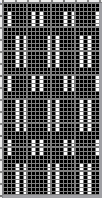 In this test swatch, the red yarn is a 2/18 silk/wool blend, and the thinner a blue polyester serger thread that forms a bubbly surface on the knit side. Colors were changed every 8 rows. The programmed electronic repeat including a knit stitch border at each side edge, 61X16
In this test swatch, the red yarn is a 2/18 silk/wool blend, and the thinner a blue polyester serger thread that forms a bubbly surface on the knit side. Colors were changed every 8 rows. The programmed electronic repeat including a knit stitch border at each side edge, 61X16 ![]()
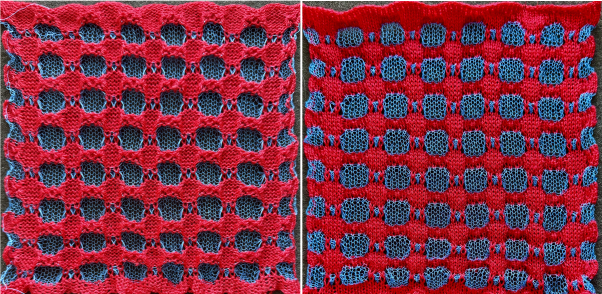 This 12X42 configuration is typical, with tuck shapes forming on a knit ground;
This 12X42 configuration is typical, with tuck shapes forming on a knit ground; 
![]() replacing knit areas with alternate tuck patterning, a larger design, 24X54
replacing knit areas with alternate tuck patterning, a larger design, 24X54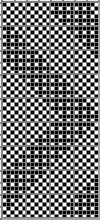
![]() rendered double length, 24X108
rendered double length, 24X108![]()
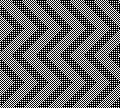
 When colors are changed every 2 rows, the result is very different than the maze/mosaic effects sometimes formed when using combined knit/tuck patterning
When colors are changed every 2 rows, the result is very different than the maze/mosaic effects sometimes formed when using combined knit/tuck patterning 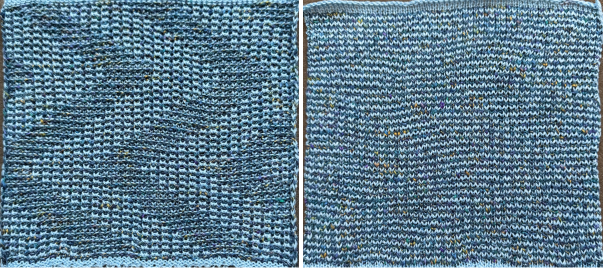 A decade ago, Ribber fabrics with main bed tuck patterning 1/ pick rib
A decade ago, Ribber fabrics with main bed tuck patterning 1/ pick rib
introduced this fabric, which lies flat and, depending on yarn choices, can appear to produce eyelets and has a soft drape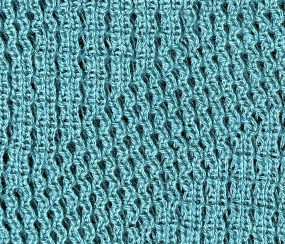
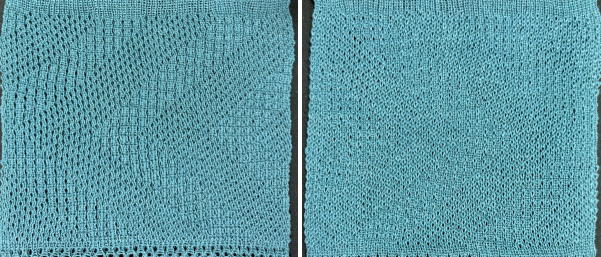 When combined with planned needles out of work, some patterns will form what are sometimes referred to as mock aran designs. This first repeat is built with simple blocks. The all-white vertical columns represent areas where needles are transferred from the main bed to the ribber. The tucked main bed areas shorten and widen the transferred stitches, pushing them apart and forming vertical “waves”.
When combined with planned needles out of work, some patterns will form what are sometimes referred to as mock aran designs. This first repeat is built with simple blocks. The all-white vertical columns represent areas where needles are transferred from the main bed to the ribber. The tucked main bed areas shorten and widen the transferred stitches, pushing them apart and forming vertical “waves”. 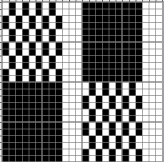
![]()
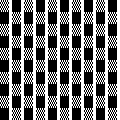 The resulting knit is narrow and retains its 3D quality if wool is used, but acrylic or blends and some natural fibers will flatten permanently if pressed.
The resulting knit is narrow and retains its 3D quality if wool is used, but acrylic or blends and some natural fibers will flatten permanently if pressed.
The proof of concept worked on 60 stitches:
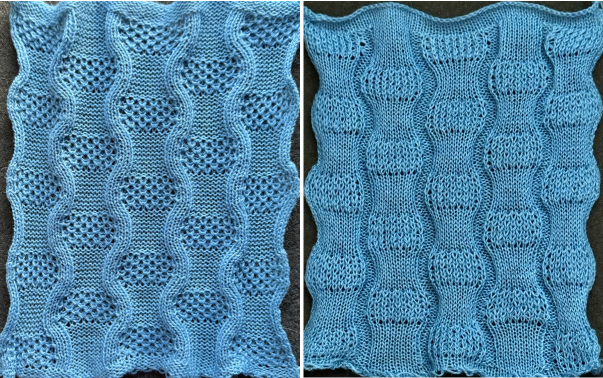 A “fail” of sorts, a diamond shape was tested. To start with, I ran out of the first yarn. There were some rough spots in the ribber-stitch formations. When steamed, the vertical knit columns flattened at the center while outlining the ruffled edges, which may serve as edgings.
A “fail” of sorts, a diamond shape was tested. To start with, I ran out of the first yarn. There were some rough spots in the ribber-stitch formations. When steamed, the vertical knit columns flattened at the center while outlining the ruffled edges, which may serve as edgings. 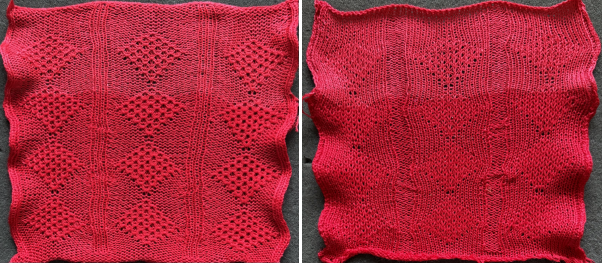 When searching for tuck aran online, all finds include single-bed patterning, where tuck/knit stitches create narrow vertical columns between the larger designs. Often, the pieces pictured are blankets produced on 9mm KM models. Fewer versions bring the ribber into play.
When searching for tuck aran online, all finds include single-bed patterning, where tuck/knit stitches create narrow vertical columns between the larger designs. Often, the pieces pictured are blankets produced on 9mm KM models. Fewer versions bring the ribber into play.
Punchcard repeats may be knitted as published on electronic machines or altered to suit.
A straightforward approach to double bed experiments is to use designated tuck lace cards and transfer any stitches on needles marked to be taken out of work down to the ribber.
Variations can begin with designs commonly found in cards supplied with new machine purchases.
In these first two samples, knit stitch blocks alternating with tuck stitch ones aim for a wavy expansion of the rib columns while keeping the 24-stitch card constraint. 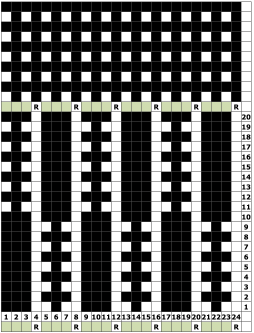 The 24X20 PNG
The 24X20 PNG ![]() was knit on 61 stitches, with a single ribber stitch border on each side.
was knit on 61 stitches, with a single ribber stitch border on each side. ![]()
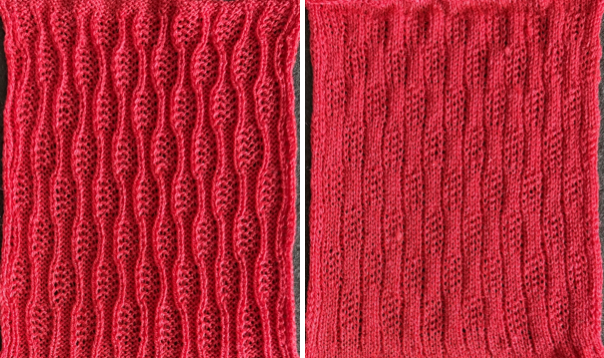
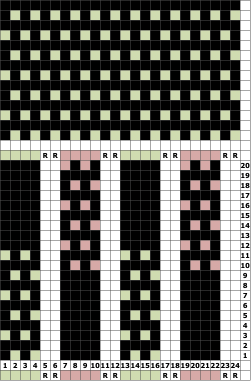 The 24X20 repeat may be punched in height X2 for use on punchcard models. The 24X20 PNG
The 24X20 repeat may be punched in height X2 for use on punchcard models. The 24X20 PNG![]() The swatch was knit on 62 stitches, with a 2-stitch rib column on each side. It was not possible to use a tighter tension on the top bed while keeping the stitch formation error-free.
The swatch was knit on 62 stitches, with a 2-stitch rib column on each side. It was not possible to use a tighter tension on the top bed while keeping the stitch formation error-free. ![]()
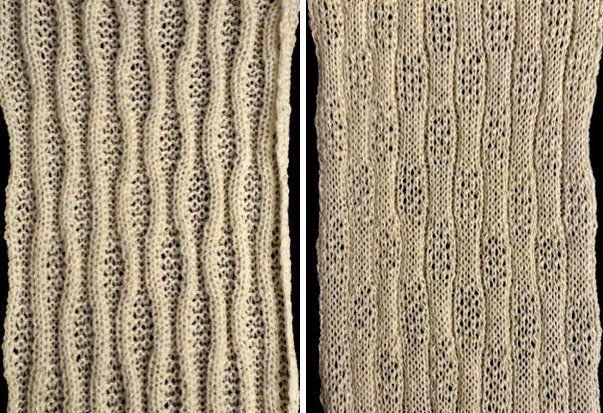 Moving from card repeats to electronic ones frees one from width 24 stitch repeat constraints, as seen here:
Moving from card repeats to electronic ones frees one from width 24 stitch repeat constraints, as seen here:
Card #3 is contained in most with purchase KM punchcard models. 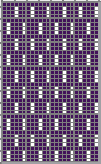
![]() Using the basic repeat, the chart shows varying the original while
Using the basic repeat, the chart shows varying the original while
making it outside the range of execution on punchcard models. 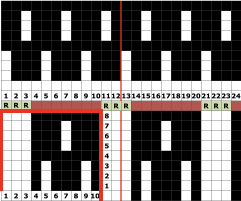 The 10X24 related chart and PNG,
The 10X24 related chart and PNG,
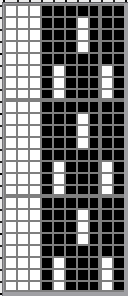
![]() The repeat used for the swatch, including planned transfers to ribber, is 63X24
The repeat used for the swatch, including planned transfers to ribber, is 63X24 ![]() the The yarn used is Merino wool.
the The yarn used is Merino wool. 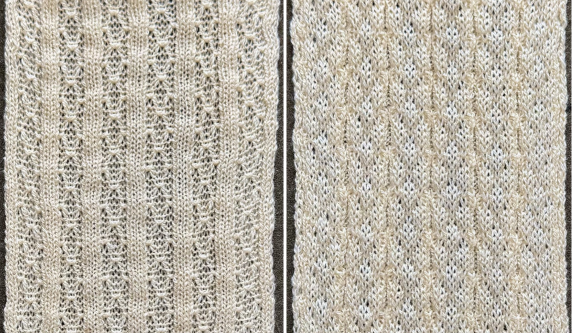 These knits narrow and lengthen when removed from the machine.
These knits narrow and lengthen when removed from the machine.
….
From a Studio punchcard volume, 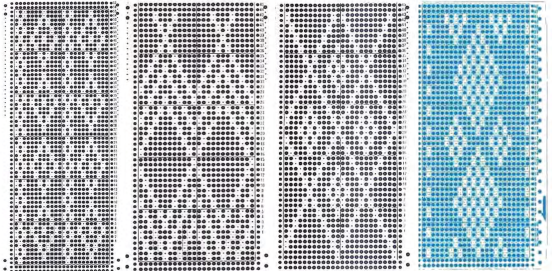 the corresponding PNGs
the corresponding PNGs
1: 24X44,![]() 2: 24X48,
2: 24X48,![]() 3: 24X48,
3: 24X48,![]() 4: 24X48,
4: 24X48, ![]() and mirrored patterning from the StitchWorld III Brother Pattern Book, 146X32
and mirrored patterning from the StitchWorld III Brother Pattern Book, 146X32![]() Beginning with the 24X44 #1 pattern, variations adding stitch transfers to ribber:
Beginning with the 24X44 #1 pattern, variations adding stitch transfers to ribber: 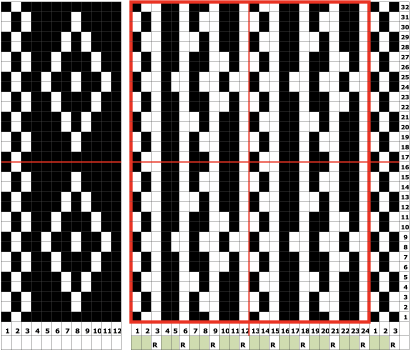 a 24X32 repeat
a 24X32 repeat
![]() planned with knit bed tuck stitch vertical borders on each side, 62X32
planned with knit bed tuck stitch vertical borders on each side, 62X32 ![]()
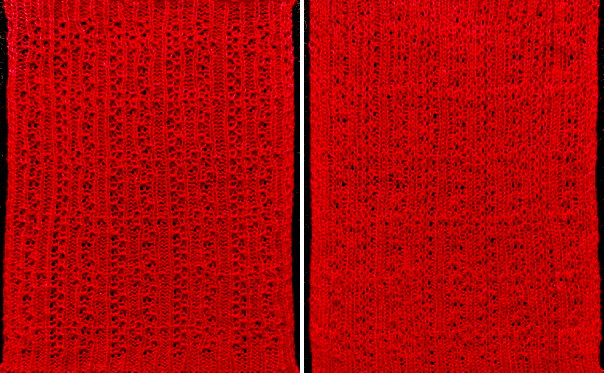 A second variation:
A second variation: 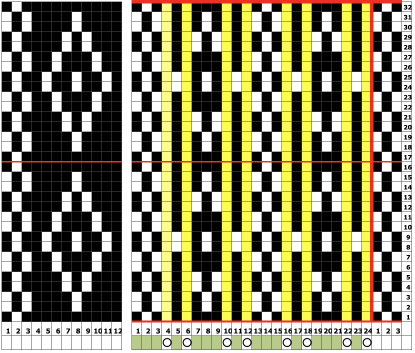 the PNG
the PNG![]() the 63X32 swatch repeat also planned with knit stitch borders on each side
the 63X32 swatch repeat also planned with knit stitch borders on each side ![]() the resulting swatch
the resulting swatch 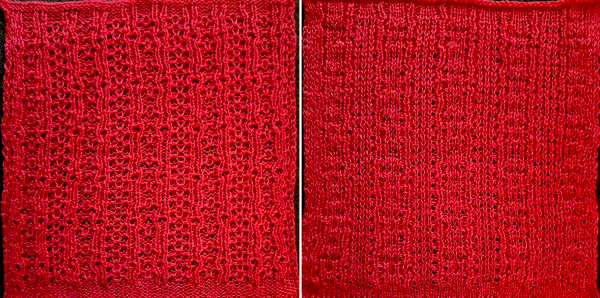 Using repeat #2
Using repeat #2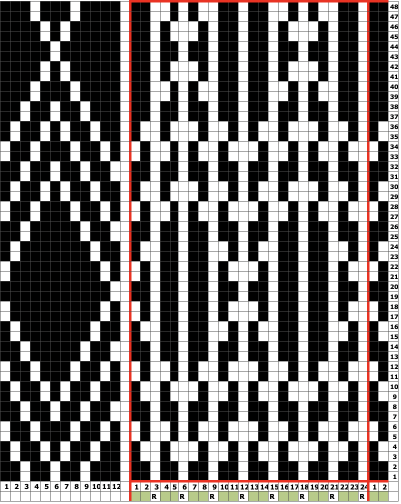 the 24X48 PNG
the 24X48 PNG![]() the swatch repeat 59X48
the swatch repeat 59X48 ![]()
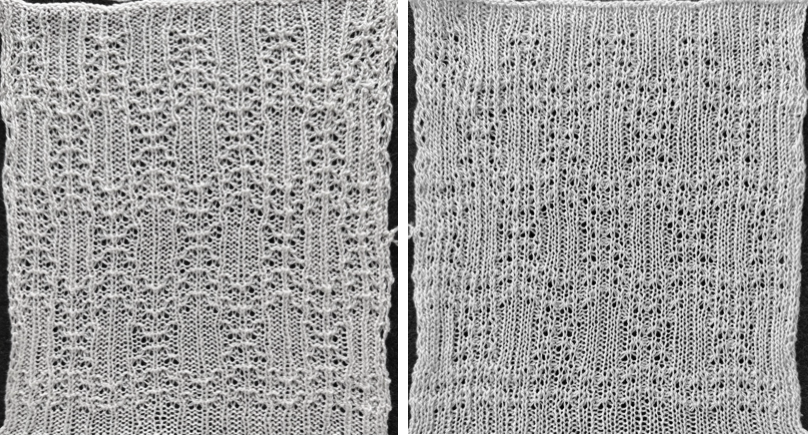 Small changes can easily be made in knit bed pattern areas to make the result more personal.
Small changes can easily be made in knit bed pattern areas to make the result more personal.
A 31X48 electronic variation combining elements from the inspiration repeats ![]() was knit single bed on 70 stitches, 48 rows with an added knit stitch programmed at each side edge
was knit single bed on 70 stitches, 48 rows with an added knit stitch programmed at each side edge![]() the yarn used is a 2/18 wool silk blend, accounting for some of the differences in shading and light sheen. After steaming and light pressing, there was some loss of the 3D textures.
the yarn used is a 2/18 wool silk blend, accounting for some of the differences in shading and light sheen. After steaming and light pressing, there was some loss of the 3D textures. 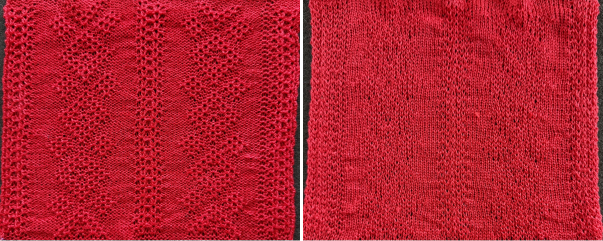 Assorted single and double bed patterns with needles out of work, NOOW:
Assorted single and double bed patterns with needles out of work, NOOW:
Tuck lace trims and fabrics 2
Tuck lace trims and fabrics 3
“Crochet” meets machine knitting techniques: tuck lace trims and fabrics 1”
“Crochet” meets machine knitting techniques: tuck lace trims or fabrics 2